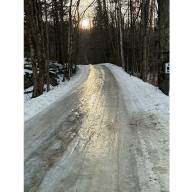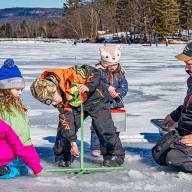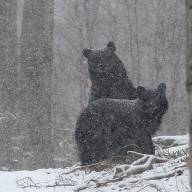The Virginia Farley Riverside Park -- formally known as the Tardy Property -- is no stranger to the war on invasives. Nestled in almost the dead center of the park is an enormous patch of Itadori knotweed, (commonly referred to as Japanese knotweed,) that has been the focus of regular attention by community volunteers and the eight University of Vermont interns. The knotweed has been cut, dug, and pulled. Another large site has been smothered.
Smothering involves cutting all of the knotweed shoots and then digging up the root balls, or the crowns. The dug area is then covered with a layer of cardboard and a large, heavy tarp. The cardboard and tarp duo suffocate any new knotweed growth, essentially draining its supply of sunlight and water. The invasive species literature suggests the knotweed will be eradicated after being smothered for five years.
Sadly, knotweed is not the only invasive impacting ecosystem stability and structure at Virginia Farley Riverside Park. The UVM interns created an inventory and map of the invasive, non-native species on the property. They found honeysuckle (Lonicera periclymenum), common buckthorn (Rhamnus cathartica), winged Euonymus (Euonymus alatus), and multi-flora rose (Rosa multiflora). After Itadori knotweed, honeysuckle is the most prevalent invasive, with 19 sites scattered throughout the park that range in size from 10 to 725-square feet. Curt Lindberg, chair of the Waitsfield Conservation Commission, has been thinking about how to address these other invasives.
“Based on the baseline inventory created by the interns we will be able to develop a comprehensive plan for invasive species management and habitat restoration and begin to implement it next year.” The park can then serve as a demonstration site for the management of common invasive species and their replacement with native shrubs and trees suitable to this riparian location along the Mad River. Our long-term goal is to help the park become a healthier and more resilient ecosystem,” Lindberg said.
These invading species have additional detrimental impacts on native species such as birds. Both buckthorn and honeysuckle induce diarrhea in birds, which spreads the undigested seeds and subsequently promoting and spreading the area of invasion of both invasive species. When birds eat honeysuckle, the berries fill them up, but the birds are unable to derive any nutrients from the berries. When birds consume buckthorn and honeysuckle, they are unable to build up their energy reserves for the winter, which they need to build up in the fall to survive. These are only some of the negative effects that invasive species have on ecosystem functioning and the survival of native species, which is why it's critical to try to mitigate or eradicate these invasive species before they do further irreparable harm to the environment.
Though a long time coming, the Itadori knotweed is slowly abating, with a more visible path to the Mad River being one of the most rewarding parts of the invasive species removal process. There is hope on the horizon for this place. It is evident after watching week after week as the knotweed is dug up and the size of the patches dwindle, that someday soon the area will be free from invasives.












